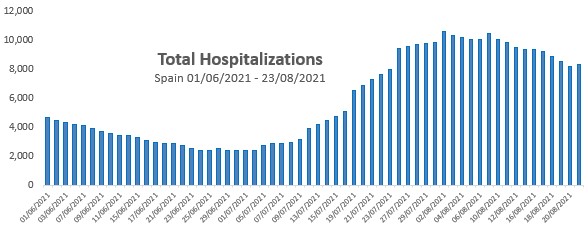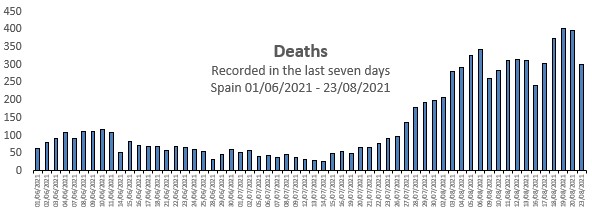VIRUS UPDATE: Positive cases drop by almost 50% in Xàbia
The Comunidad Valenciana looks set to drop out of the Extreme Risk level this week.

Tuesday 24th August 2021 – Compiled by MIKE SMITH
Xàbia
The total number of positive coronavirus cases detected by PCR test in Xàbia has climbed to 2,252, according to the latest update from the regional health ministry, a rise of 31 since the last update on Friday 20th August.
The municipality’s 14-day IA rate, a measure of the speed at which the virus moves through the population, has dropped to 442.60 cases per 100,000 inhabitants and the town remains in the ‘Extreme Risk’ alert level.

There have been no new deaths in Xàbia since late March and the number remains at 12.
Marina Alta
There have been 526 new positive cases detected by PCR test in the Marina Alta in the past 14 days and the region’s 14-day IA rate has dropped to 308.28 cases per 100,000 inhabitants and it remains in the ‘Extreme Risk’ alert level. The detection of positive cases of COVID-19 in the region has dropped by 48% in the past two weeks.

There have been 0 new deaths since the last update and the region’s toll remains at 205.
The total number of positive cases since the pandemic began is now 14,130 since the last update on Tuesday 17th August, a rise of 114.
- 32 – Dénia
- 31 – Xàbia
- 20 – Teulada-Moraira
- 13 – Calp
- 3 – Benissa; El Vergel; Pedreguer.
- 2 – Gata de Gorgos, el Poble Nou de Benitatxell.
- 1 – Els Poblets; Ondara; Xaló.
Municipalities at EXTREME RISK level
Calp; Dénia; El Vergel; Teulada-Moraira; Xàbia.
Municipalities at HIGH RISK level
Benissa; Pedreguer.
Municipalities at MEDIUM RISK level
Els Poblets; Gata de Gorgos; Ondara; Parcent; el Poble Nou de Benitatxell; Sanet y Negrals; la Vall de Laguar; Xaló.
Municipalities at LOW RISK level
Orba.
Autonomous Regions at NEW NORMAL level
Adsubia; Alcalalí; Beniarbeig; Benidoleig; Benigembla; Benimeli; Castell de Castells; Llíber; Murla; el Ràfol d’Almúnia; Sagra; Senija; Tormos; la Vall d’Alcala; la Vall d’Ebo; la Vall de Gallinera.
Spain
Spain’s 14-day IA rate is 317.35 cases per 100,000 inhabitants, a drop of more almost 24% in the last week, but the country remains in the ‘Extreme Risk’ category.
The Positivity Rate, the measure of how many coronavirus tests return positive, has dropped to 10.79%. A value of 5% or less indicates that transmission of the virus is more or less under control.

Hospitalizations
According to the latest report from the CCAES, there are 8,330 hospitalized due to COVID-19 across Spain, a drop of almost 20% on two weeks ago, of which 1,839 have been admitted to ICU wards, a drop of almost 9.5% on two weeks ago. The percentage of beds in general wards occupied by patients suffering from COVID-19 is 7.11% whilst the percentage of beds in ICU wards occupied by COVID-19 patients is 20.04%.

Cataluña still leads the way in hospitalizations, with 1,838 people currently in hospital due to COVID-19, of which 39.47% have been admitted to ICU wards for extreme cases. The autonomous region of Madrid is not far behind, with 1,685 people in hospital, of which 34.25% are in ICU wards, whilst Andalucia has 1,290 people in hospital, 12.57% of which are being cared for in ICU wards.
In the Comunidad Valenciana, 546 people are currently hospitalized, according to the latest CCAES report, with 13.57% of ICU ward capacity occupied by those suffering from the extreme effects of COVID-19.
Deaths
The country has suffered 301 deaths in the past seven days, a rise of almost 15% when compared to two weeks ago. This appears to be the normal progress of the infection spread: positive cases rise, then hospitalizations increase, and finally the number of deaths increase. This can clearly been seen in the three charts given in this summary for Spain.
The national death toll rises to 83,337 since the pandemic began.

Regional Data
Across Spain, the rise of infections continues to slow with all but one of the 19 autonomous regions have reported IA rates lower than they were two weeks ago. The North African enclave of Ceuta (605.69) is the odd one out with a 68% rise in infections in a fortnight but this has been attributed to 93 of the new cases in the last seven days corresponding to outbreaks in migrant reception centres in the city.
Behind Ceuta, just two regions remains above 400: Extremadura (482.05), and La Rioja (405.73).
At the other end of the scale remains Asturias (145.96) with the Canarias on 218.52.
The Comunidad Valenciana’s rate, currently 262.23, has almost halved in the past two weeks and it remains the autonomous region with the second lowest rate in mainland Spain behind Asturias.
Autonomous Regions at EXTREME RISK level
Andalucia; Aragón; Baleares; Cantabria; Castilla y León; Castilla-La Mancha; Cataluña; Ceuta; Comunidad Valenciana; Extremadura; Galicia; La Rioja; Madrid; Melilla; Murcia; Navarra; País Vasco.
Autonomous Regions at HIGH RISK level
Asturias; Canarias.
Autonomous Regions at MEDIUM RISK level
None
Autonomous Regions at LOW RISK level
None
Autonomous Regions at NEW NORMAL level
None
The newspaper El Pais has reported that measures are to remain in place in schools in Spain when the new school year starts in September, despite nearly half of students aged 12 to 18 fully vaccinated against COVID-19 and a large part of the rest having received their first dose. Experts have said that the wearing of masks will have to be maintained but are confident that infections will remain low, despite the presence of the more-contagious Delta variant.
How does Spain compare to the rest of Europe?
Top 20 table based on new confirmed COVID-19 cases per 1 million population on August 19th 2021.
- Kosovo (982.62) ↑
- Montenegro (883.44) ↑
- United Kingdom (483.80) ↑
- North Macedonia (462.50) ↑
- Cyprus (388.19) ↓
- Republic of Ireland (362.19) ↑
- France (320.68) ↓
- Greece (308.04) ↓
- Switzerland (297.61) ↑
- Liechtenstein (250.97) ↓
- Iceland (250.76) ↓
- Monaco (243.90) ↑
- Turkey (233.25) ↓
- Spain (229.42) ↓
- Serbia (227.12) ↑
- Portugal (225.23) ↓
- Estonia (212.26) ↑
- Lithuania (205.50) ↑
- Albania (177.42) ↑
- Belgium (169.15) ↑
↑ = infection spread rising
↓ = infection spread dropping
Source: ourworldindata.org
Vaccination (23.08.21)
Spain has administered 63,590,985 doses of vaccine, which is 93.1% of those which it has already received (68,314,152). A total of 31,447,188 people have completed the recommended course, which is 74.7% of the total of the population which is to be vaccinated (42,119,827) or 66.3% of the total population of Spain.
According to the latest data provided by the health authorities, 93.8% of people aged 40 and over in Spain have received at least one dose, with 91.3% having completed the recommended course.
The Comunidad Valenciana has administered 6,696,829 doses of vaccine, which is 94.0% of the total which it has received (7,125,800). A total of 3,237,321 people have completed the recommended course, which 72.1% of the population which is to be vaccinated (4,488,459) or 64.0% of the total population of the Comunidad Valenciana.
According to the latest data provided by the health authorities, 94.4% of people aged 40 and over in the Comunidad Valenciana have received at least one dose, with 92.1% having completed the recommended course.
The newspaper El Pais has reported that Spain is reducing the gap between infection and vaccination in a bid to speed up a flagging campaign. This measure will allow for the vaccination of 500,000 people one or two months after catching the coronavirus infection instead of the original six months. This group accounts for nearly 2% of the Spanish population, a figure that, at this stage of the vaccination campaign, is not as small as it may appear.
How does Spain compare to the rest of Europe?
Top 20 table based on percentage of total population fully vaccinated.
- Malta (79.52%)
- Iceland (74.82%)
- San Marino (69.87%)
- Denmark (69.61%)
- Belgium (67.86%)
- Portugal (67.48%)
- Spain (67.26%)
- Republic of Ireland (65.56%)
- Netherlands (61.80%)
- United Kingdom (61.59%)
- Germany (58.53%)
- Italy (58.56%)
- Hungary (56.96%)
- Austria (56.88%)
- Cyprus (56.78%)
- Luxembourg (56.03%)
- France (55.57%)
- Greece (54.07%)
- Liechtenstein (53.54%)
- Lithuania (53.13%)
Source: ourworldindata.org
LINKS
- Actualización nº 446. Enfermedad por el coronavirus (COVID-19). 23.08.2021
- GIV COVID-19 Gestión integral de la vacunación COVID-19
- COVID-19 C. Valenciana: Monitoratge de la situació




